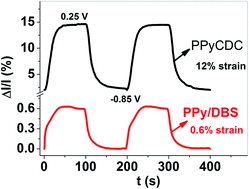Carbide-derived carbon in polypyrrole changing the elastic modulus with a huge impact on actuation
Abstract
While carbide-derived carbon (CDC)-based materials have shown stable behavior in ionic electro-chemo-mechanical actuators, the displacement and actuation speed have remained low compared to conducting polymer-based actuators. The goal of this research was to obtain more responsive conducting polymer–CDC composite films and to investigate their linear actuation properties, comparing the stress and strain to those of polypyrrole (PPy) doped with dodecylbenzenesulfonate (DBS−). The PPy–CDC hybrid films were synthesized electrochemically using polyoxometalate (POM) (phosphotungstic acid) to attach charge to the CDC particles for embedding them into the PPy matrix as secondary dopants in addition to DBS−. Cyclic voltammetry and square wave potential steps in electro-chemo-mechanical deformation (ECMD) measurements were performed in aqueous electrolyte solution, showing that the PPy–CDC hybrids had higher strain (12%) and stress (0.6 MPa) than the PPy/DBS films. The new composite was investigated by scanning electron microscopy (SEM) and energy dispersive X-ray (EDX) spectroscopy to evaluate the composition of these promising materials.


 Please wait while we load your content...
Please wait while we load your content...